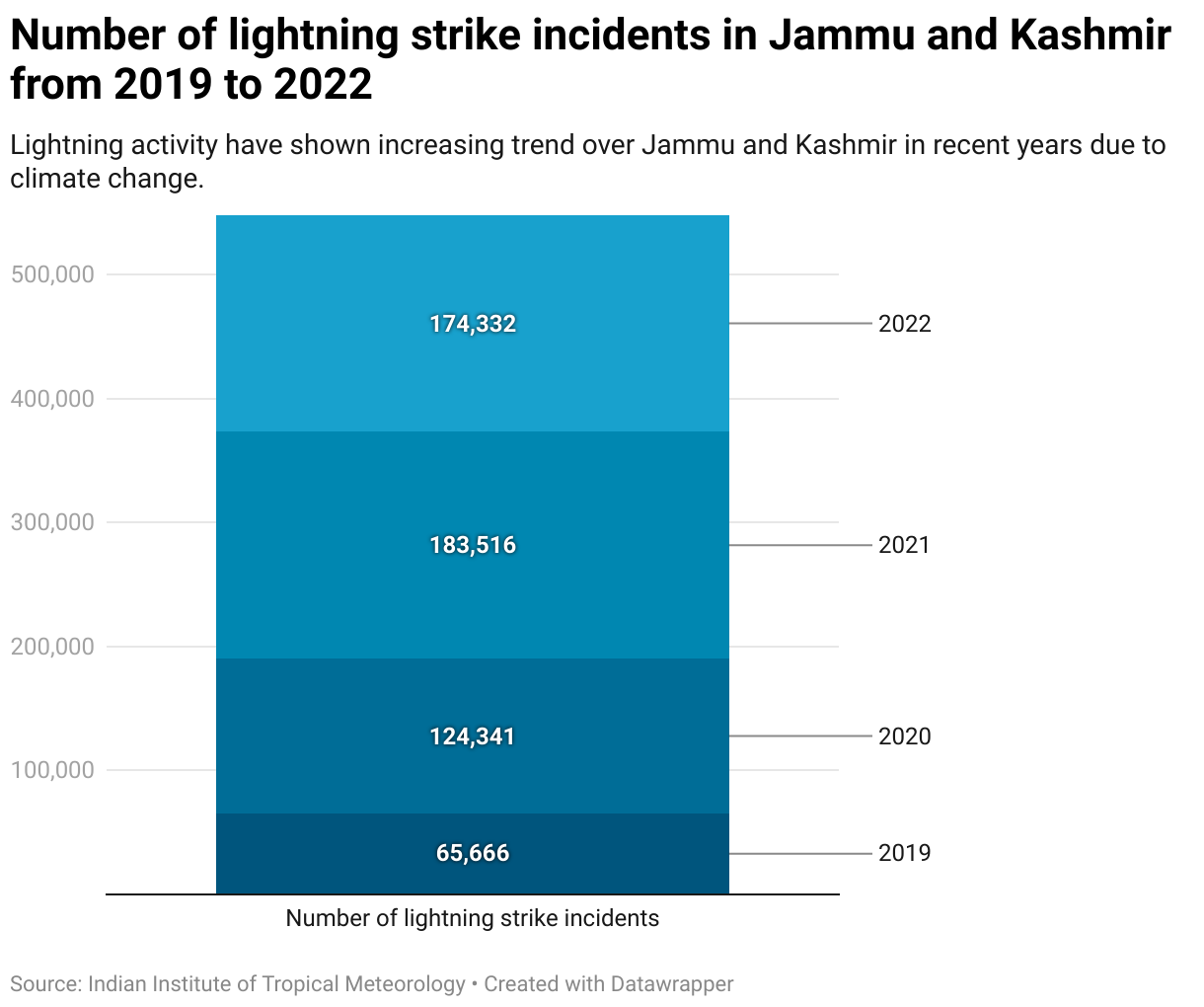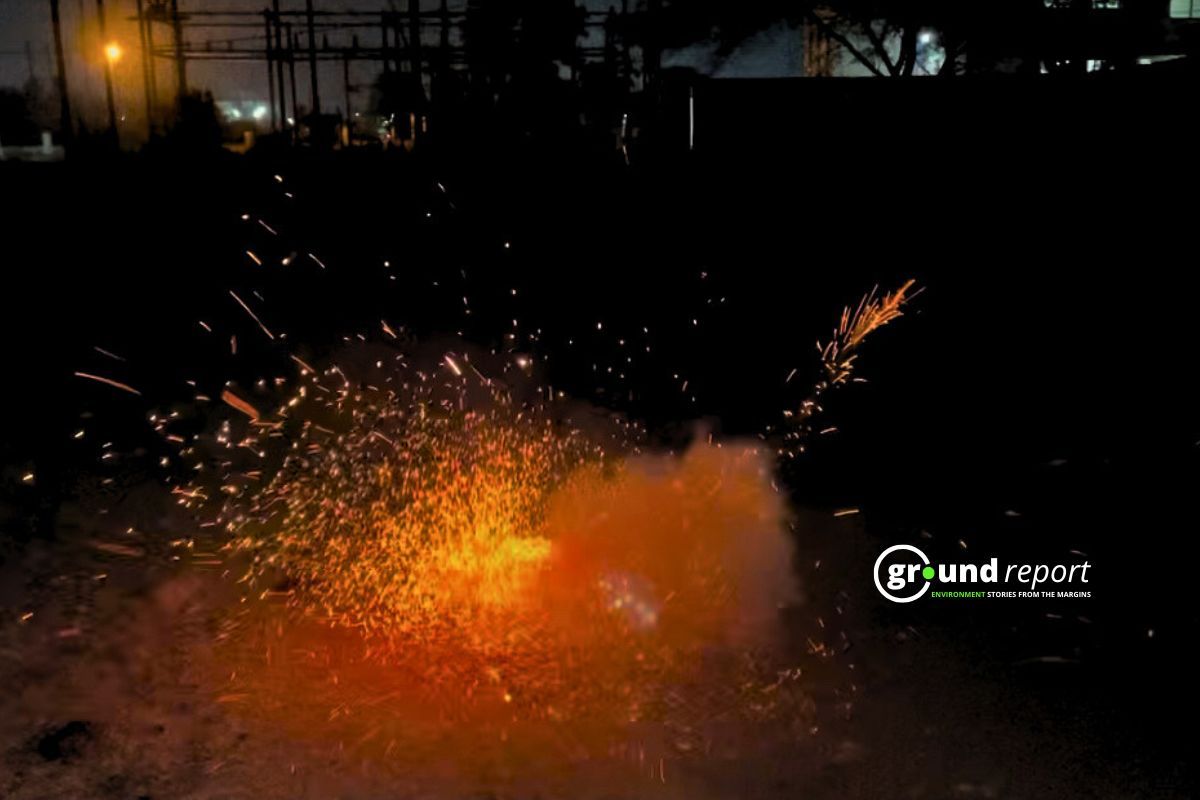30-year-old Rafakat Khan called out to his mother as a loud thunderclap broke the silence of the morning stillness. Early in the morning, lightning strikes on April 29th killed livestock that were seeking refuge from the heavy rain under a mango tree.
“The powerful lightning struck, immediately killing 30 goats and wounding 15 sheep belonging to two families in the village,” Khan said.
Rafakat Khan and Mohammad Showkat, two pastoralists from Baba Abdu Nath village in the Samba district of Jammu and Kashmir, share a bond forged not merely by their common profession but by the shared pain of losses caused by lightning strikes. Rafakat and Showkat are from the Gujjar community, a nomadic community in Kashmir. The families belonged to the marginalised Scheduled Tribe (ST) community.
Reflecting on the incident, 32-year-old Mohammad Showkat expressed his disbelief at the tragedy. “I’ve been rearing these animals for over 21 years, but I’ve never witnessed anything like this (lightning).”
Khan narrates the incident with fear. “These were my childhood sheep and goats,” he said, his voice trembling with emotion. “Out of 50 goats and sheep, 30 were killed. Of those, 26 were my sheep, 16 of my goats and sheep died and 24 belonged to Showket. In total, 14 of his goats and sheep died, and 10 were injured.”

It was just another normal night for Rafakat,
“This is our livelihood, and I have lost everything… Four of the goats were pregnant, adding to the heartbreak.” Rafakat lamented, his eyes welling up with tears.
Meagre compensation
According to an unstarred question in the Lok Sabha, the Jammu and Kashmir government provides Rs 3,000 in compensation for the loss of sheep or goats due to disaster. However, the sheep costs between Rs 15,000 and Rs 20,000 in the market, depending on the weight. The people from the shepherd community don’t always own the livestock; rather, they just rear the livestock of other villagers on seasonal basis. And they are paid for these services. Hence, in the event of lightning strikes, they are never compensated for their loss of livelihood, as the compensation for the dead livestock would go to the owner.
Speaking to Ground Report, Nawaz Sharif, District Social Welfare Officer and Additional Secretary of India Red Cross Society, said,
“I have asked the authority to pay them some compensation firsthand. This is just a relief fund from the Red Cross for the loss as a firsthand I don’t know about the rules. Anybody who needs help can get funds from the Red Cross, whether due to natural disasters or human-made disasters. There are rules for other departments, like the husbandry sheep department and animal husbandry department. But for the Red Cross, there is no rule,” he further added.
Red Cross Society is a humanitarian organization aiding crisis-affected families. The incident has also raised concerns about the lack of adequate support from authorities. Rafakat revealed,
“The Sheep husbandry department asked for a report, but they have not responded so far. I have demanded that they provide livestock through sheep husbandry scheme, where we can buy 50 the sheep and receive a subsidy of Rs. 2,50,000.”
The Jammu and Kashmir (J&K) Sheep Husbandry Department provides a 50% subsidy of up to Rs 2.50 lakh per unit for the establishment of sheep or goat units (a minimum of twenty sheep/goats are in one unit). The maximum subsidy is Rs 1 lakh per unit for 20–200 ewes or does, and the maximum subsidy ceiling is Rs 8 lakh for eight units of 25 sheep or goats each.
Showkat repeated similar sentiments, stating, “The SHO (Station House Officer) and the Tehsildar (revenue officer) visited the spot, but nothing has happened yet.”
Ground Report tried to reach out to the Sheep Husbandry Department in Jammu. We will update this story when we receive a response.
Lives and livelihoods
The tragedy has highlighted the vulnerability of the Gujjar-Bakarwal community, primarily nomadic pastoralists and one of the most marginalised communities in the region. Abdu Nath village, where the incident occurred, is home to many Gujjar Bakarwal families.
The lives and livelihoods, of the nomadic pastoralists are interlinked with their livestock. The lightning strike has not only caused huge emotional distress but also placed a marked financial burden on the affected families. Rafakat, who suffers from a disability in his right leg due to polio, making it difficult for him to find alternative employment, expressed his distress. “I am handicapped and unable to work elsewhere. I have lost everything.”
Showkat vividly described the moments leading up to the tragedy.
“I was 100 meters away when this happened, and I heard a loud sound. When I reached the spot around 3:05 AM, I saw death and devastation—goats lying lifeless, and others running away in fear.

Nomadic tribes are particularly vulnerable to the impact of climate change. These communities are battling the fight of rapid urbanisation, and their traditional practices. Due to their nomadic culture, the community has low literacy rates. Hence, people from the community travel to the cities for labour work. Amidst this, inadequate compensation aggravates the suffering of the marginalised section of society.
Rise in lightning incidents
Recent data from the Indian Institute of Tropical Meteorology reveals a concerning trend of rising lightning incidents in Jammu and Kashmir, particularly from June to September. The state has witnessed a staggering 172.39% increase in lightning occurrences from 2019 to 2022.
Lightning typically occurs when towering cumulonimbus clouds extend approximately twelve to fifteen kilometres above the ground. The likelihood of thunder and lightning is heightened when the cloud temperature ranges between 0°C and -40°C.
“The rain was not that heavy, and I am confused about how this lightning could have happened in our area. We are now really worried that such things might happen again, as these animals are our labour and our everything,” said Showkat.
Researchers from the Divecha Centre for Climate Change at the Indian Institute of Science (IISc), Bengaluru, shed light on the nationwide surge in lightning strikes. Their findings indicate a notable 25% increase in lightning events across India between 1998 and 2014. Alarmingly, the trend has intensified in recent years, with a significant 34% rise observed in just the last two years, as per the Annual Lightning Report 2020-2022.
We (the Ground Report) had previously reported on the impact of lightning strikes on the nomadic communities in Kashmir. The administration has yet to take a serious look at the issue. In the Bageshwar district of Uttarakhand, 121 goats died in a lightning strike incident. The hilly states of India are greatly vulnerable to the impact of climate change. For days, the state was experiencing forest fires in the Nainital region. Later, flash floods and hailstorms helped put down the fire, but they wreaked havoc in the area.
Furthermore, experts believe lighting strikes and increasing extreme weather events are a big threat in times of climate change. Climate change causes warmer air, which can hold more moisture, leading to more thunderstorms and lightning strikes. According to a 2021 study, the frequency of lightning in India could increase by 10–25% and its intensity could increase by 15–50% by the end of the century.
Keep Reading
Part 1: Cloudburst in Ganderbal’s Padabal village & unfulfilled promises
India braces for intense 2024 monsoon amid recent deadly weather trends
Support us to keep independent environmental journalism alive in India.
Follow Ground Report on X, Instagram and Facebook for environmental and underreported stories from the margins. Give us feedback on our email id greport2018@gmail.com.
Don’t forget to Subscribe to our weekly newsletter, Join our community on WhatsApp, and Follow our YouTube Channel for video stories.






